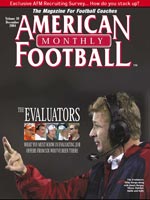AMERICAN FOOTBALL MONTHLY THE #1 RESOURCE FOR FOOTBALL COACHES
Article CategoriesAFM Magazine
|
Being in the Right Place at the Right TimeDefensive backfield positioning, alignment and int\'sCornerbacks Coach, Western Michigan University © More from this issue There are several key points that can be helpful in developing your Defensive Backs. Many coaches have used these ideas and techniques over the years. It is my hope that you will gain something that will help you in some way 1. Stance - Specific Points for Stance: • Head and eyes should be up • Outside foot up with a heel/toe relationship on the inside foot • Knees bent with flexion in the ankles • Chest high with chin over the knees • Body should be in what we call a ‘Striking Angle-Z’ • Elbows should be bent, tight against the body, with hands in a combat position ....The full article can only be seen by subscribers. Subscribe today!
|
|
|||||||
| HOME |
MAGAZINE |
SUBSCRIBE | ONLINE COLUMNISTS | COACHING VIDEOS |
Copyright 2025, AmericanFootballMonthly.com
All Rights Reserved





